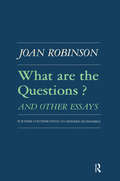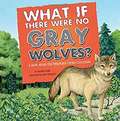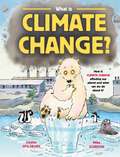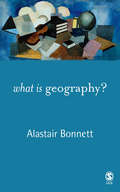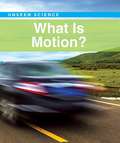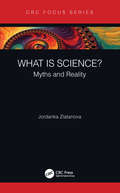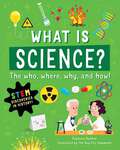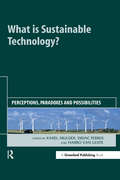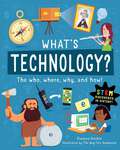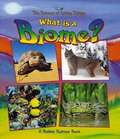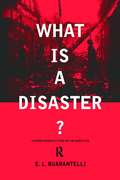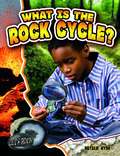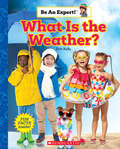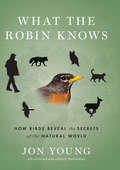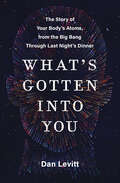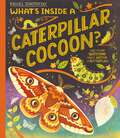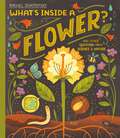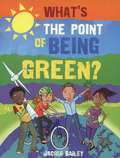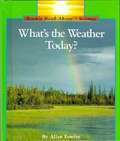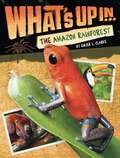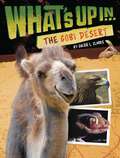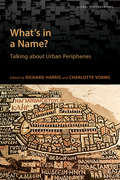- Table View
- List View
What are the Questions and Other Essays: Further Contributions to Modern Economics
by Robert K RobinsonA study of environmental degradation, this work presents the environmental problems of South Korea. The effects of rapid industrialisation and modernisation are documented along with the choices and actions which are available to the country.
What if There Were No Gray Wolves: A Book About The Temperate Forest Ecosystem (Food Chain Reactions)
by Suzanne Buckingham SladeDeciduous forest ecosystems can be found on nearly every continent. Countless animals and plants live in them. So what difference could the loss of one animal species make? Follow the chain reaction, and discover how important gray wolves are.
What is Climate Change?
by Louise SpilsburyEverything you need to know about climate change from the causes to the evidence to the effects and what you can do to help combat it.Climate change is already having dramatic and dangerous effects on life on Earth. But what does climate change really mean? What are people doing that could cause the whole planet to get warmer? How can simply driving a car or eating a burger end up impacting Earth's climate? From fossil fuels and deforestation to car use and cow farts, we uncover the culprits of climate change and work out what can be done to combat it.Scientists, inventors and technicians are coming up with creative solutions to try to reduce the effects of climate change, such as building floating homes, restoring flood plans and conserving water.We show how proactive and inspiring people are taking action around the world from campaigning to making practical changes to their everyday lives, and you can find out what you can do to help too.
What is Geography?
by Alastair Bonnett"I cannot imagine a better guide to the transition between school and undergraduate geography than this short, informative and confidently-argued book. Written without fuss but based on solid learning and clear thinking, it tackles head-on a question many professional academic geographers would rather avoid." - Alisdair Rogers, University of Oxford "A beautiful little book that helps to introduce the core concepts of geography and provides an ideal framework for relating other fields of knowledge and academia." - Stefan Zimmermann, University of Osnabruck What is Geography? Geography is a fundamental fascination with, and a crucial method for, understanding the way the world works. This text offers readers a short and highly accessible account of the ideas and concepts constituting geography. Drawing out the key themes that define the subject, What is Geography? demonstrates how and why these themes - like environment and geopolitics- are of fundamental importance. Including discussion of both the human and the natural realms, the text looks at key themes like environment, space, and place - as well as geography′s methods and the history of the discipline. Introductory but not simplified, What is Geography? will provide students with the ability to understand the history and context of the subject without any prior knowledge. Designed as a key transitional text for students entering undergraduate courses, this book will be of interest to all readers interested in and intrigued by the "geographical imagination".
What is Motion? (Unseen Science)
by Laura L. SullivanWhat Is Motion? introduces readers to the science behind that question, explaining the physics behind the phenomenon through graphs and activities. Easy-to-understand summaries following each chapter highlights the most important points for review
What is Science?: Myths and Reality
by Jordanka ZlatanovaIn a multitude of ways, science affects the life of almost every person on earth. From medicine and nutrition to communication and transportation, the products of scientific research have changed human life. These changes have mostly taken place in the last two centuries, so rapidly that the average person is unable to keep informed. A consequence of this "information gap" has been the increasing suspicion of science and scientists. The lack of true understanding of science, especially of "fundamental" research, motivates this effort to narrow this gap by explaining scientific endeavor and the data-driven worldviews of scientists. Key Features Fills an existing void in the understanding of science among the general population Is written in a nontechnical language to facilitate understanding Covers a wide range of science-related subjects: The value of "basic research" How scientists work by sharing results and ideas How science is funded by governments and private entities Addresses the possible dangers of research and how society deals with such risks Expresses the viewpoint of an author with extensive experience working in laboratories all over the world
What is Science?: The Who, Where, Why, and How
by Frances DurkinFact-filled non-fiction that uncovers the who, where, why, and how of amazing scientific discoveries throughout history.From the explosion at the start of the universe to atomic energy and the impact of immunization the contents focus on the people behind the science and the history happening at the time. Included within the book is a contents list at the front and a glossary at the back plus a "take it further" activity on each page. Discover the human side of STEM!
What is Sustainable Technology?: Perceptions, Paradoxes and Possibilities
by Karel Mulder Didac Ferrer Harro van LenteDesigners of technology have a major responsibility in the current age. Their designs can have tremendous effects on society, in both the short and the long term. In fact, sustainable development itself has all the characteristics of a design project, albeit a vast one. But a failed product design here will be not just be unsuccessful in the market – it will have far-reaching consequences. It is our common responsibility to make the project successful. Technology has played an important role in creating the problems that we now face; but it will also play an important role in solving them. But this does not mean the technological fix will be easy. How do we allocate resources and attention when there are myriad issues under the umbrella of "sustainable development" currently in competition with one another? How do we arrive at precise specifications for the sustainable technologies that are to be developed and, furthermore, reach consensus on these specifications? What if our sustainable technological solutions aggravate other problems or create new ones? And, because sustainable development is all about the long-term consequences of our actions, how do we assess the effects of modifying existing landscapes, infrastructures and patterns of life?How could we be sure in advance that the changes that new technologies bring will make our society more sustainable? These dilemmas and paradoxes are the subject of this provocative book. Sometimes the claim that a technology is sustainable is made in order to make the technology acceptable in the political process, as in the case of nuclear energy production, where the claims of "sustainability" refer to the absence of CO2 emissions. In the case of biofuels, claims of sustainability have led to a "fuel or food" debate, showing that sustainability has counteracting articulations. And the well-known rebound effect is observed when increased resource efficiency can create a stimulus for consumption. What is Sustainable Technology? illustrates that the sustainability impact of a technology is often much more complicated and ambivalent than one might expect. Making improvements to existing designs is not the technological challenge that will lead to real solutions. We mustn't look to change a part of a machine, but rather the machine as a whole – or even the whole system in which it functions. It is these system innovations that have the potential to make a genuine contribution to sustainable development. What is Sustainable Technology? will help all those involved in designing more sustainable technologies in determining their strategies. It does so by presenting case studies of different technologies in contrasting contexts. Each case asks: 1. What articulations of sustainability played a role in the design process? 2. What sustainability effects did this technology lead to? 3. Who was affected, where, and when? 4. Could the designer have foreseen these consequences? 5. How did the designer anticipate them? 6. How was societal interaction dealt with during the design process? Finally, the authors reflect on future options for the sustainable technology designer. They argue that an important first step is an awareness of the multitude of sustainable development challenges that play a role in production, use, recycling and end-of-life disposal. What is Sustainable Technology? will be essential reading for product designers, engineers, material scientists and others involved in the development of sustainable technologies, as well as a wide academic audience interested in the complexities of the sustainable design process.
What is Technology?: The Who, Where, Why, and How
by Frances DurkinFact-filled non-fiction that uncovers the who where why and how of amazing technological inventions throughout history. From the magic of making music to lightbulb moments and tiny technology the contents focus on the people behind the inventions and the history happening at the time. There is a contents list at the front of the book and a glossary at the back plus a "take it further" activity on each page. Discover the human side of STEM!
What is a Biome? (The Science of Living Things)
by Bobbie KalmanIntroduces biomes, showing and describing the main kinds and discussing their location, climate, and plant and animal life, as well as those developed by humans. Lexile Measure: NC910L
What is a Disaster?: A Dozen Perspectives on the Question
by E. L. QuarantelliAre conflict situations such as the ethnic clashes in Yugoslavia or Rwanda, terrorist attacks and riots, the same kind of social crises as those generated by natural and technological happenings such as earthquakes and chemical explosions? In What is a Disaster?, social science disaster researchers from six different disciplines advance their views on what a disaster is. Clashes in conceptions are highlighted, through the book's unique juxtaposition of the authors separately advanced views. A reaction paper to each set of views is presented by an experienced disaster researcher; in turn, the original authors provide a response to what has been said about their views. What is a Disaster? sets out the huge conceptual differences that exist concerning what a disaster is, and presents important implications for both theory, study and practice.
What is the Rock Cycle?
by Natalie HydeThis book talks all about the life cycle of rocks--their origin, types, and other interesting facts.
What is the Weather? (Be an Expert!)
by Erin KellyKids love to be the experts! Now they can feel like real pros with this exciting nonfiction series for beginning readers. Kids will be hooked on the thrilling real-world topics and big, bright photos. Each book features simple sentences and sight words that children can practice reading. Then, with support, kids can dig deeper into the extra facts, Q&As, and fun challenges.Fans of this series will be eager to become real experts!Sometimes it is cold outside. We have to bundle up. Sometimes it is hot. We don’t even need a coat. The weather is always changing! What do you know about days that are sunny, cold, rainy, or dry? With this book you can become an expert!
What the Robin Knows
by Jon YoungCompanion audio files are available at www.hmhbooks.com/whattherobinknows A lifelong birder, tracker, and naturalist, Jon Young is guided in his work and teaching by three basic premises: the robin, junco, and other songbirds know everything important about their environment, be it backyard or forest; by tuning in to their vocalizations and behavior, we can acquire much of this wisdom for our own pleasure and benefit; and the birds' companion calls and warning alarms are just as important as their songs. Birds are the sentries--and our key to understanding the world beyond our front door. Unwitting humans create a zone of disturbance that scatters the wildlife. Respectful humans who heed the birds acquire an awareness that radically changes the dynamic. We are welcome in their habitat. The birds don't fly away. The larger animals don't race off. No longer hapless intruders, we now find, see, and engage the deer, the fox, the red-shouldered hawk--even the elusive, whispering wren. Deep bird language is an ancient discipline, perfected by Native peoples the world over. Finally, science is catching up. This groundbreaking book unites the indigenous knowledge, the latest research, and the author's own experience of four decades in the field to lead us toward a deeper connection to the animals and, in the end, a deeper connection to ourselves.
What's Gotten Into You: The Story of Your Body's Atoms, from the Big Bang Through Last Night's Dinner
by Dan LevittFor readers of Bill Bryson, Neil deGrasse Tyson and Siddhartha Mukherjee, a wondrous, wildly ambitious, and vastly entertaining work of popular science that tells the awe-inspiring story of the elements that make up the human body, and how these building blocks of life travelled billions of miles and across billions of years to make us who we are.Every one of us contains a billion times more atoms than all the grains of sand in the earth’s deserts. If you weigh 150 pounds, you’ve got enough carbon to make 25 pounds of charcoal, enough salt to fill a saltshaker, enough chlorine to disinfect several backyard swimming pools, and enough iron to forge a 3-inch nail. But how did these elements combine to make us human? All matter—everything around us and within us—has an ultimate birthday: the day the universe was born. This informative, eye-opening, and eminently readable book is the story of our atoms’ long strange journey from the Big Bang to the creation of stars, through the assembly of Planet Earth, and the formation of life as we know it. It’s also the story of the scientists who made groundbreaking discoveries and unearthed extraordinary insights into the composition of life. Behind their unexpected findings were investigations marked by fierce rivalries, obsession, heartbreak, flashes of insight, and flukes of blind luck. Ultimately they’ve helped us understand the mystery of our existence: how a quadrillion atoms made of particles from the Big Bang now animate each of our cells.Shaped by the curious mind and bold vision of science and history documentarian Dan Levitt, this wondrous book is no less than the story of life itself.
What's Inside Shells
by Richard Manning Angela RoystonWhy does a sea urchin have sharp spines? What does a tortoise look like inside his shell? How can you tell how old an oyster is? Take a look! What's Inside? is a fascinating new series that looks beneath the surface of everyday things and explains how and why they work as they do. With a unique combination of vivid photography and colorful illustration, What's Inside? peels away the outer layers to reveal an exciting world for children to explore.
What's Inside a Caterpillar Cocoon?: And other questions about moths and butterflies
by Rachel IgnotofskyButterflies soar in the sunlight while moths flutter under the moon and stars, and both have been around since the dinosaurs roamed the Earth! From pupas inside a chrysalis or cocoons to camouflaging techniques and what butterflies and moths eat, find out more about these mysterious and majestic insects' similarities and differences, and their awe-inspiring metamorphosis!From the creator of the New York Times bestseller Women in Science, Rachel Ignotofsky, What's Inside a Caterpillar Cocoon? is the perfect book for young scientists who want to grow by nurturing their curiosity about the natural world.
What's Inside a Flower?: And other questions about science and nature
by Rachel IgnotofskyFrom pollination and scattering seeds to labelled diagrams of roots, stamens and stems, discover everything there is to know about flowers. Flowers live everywhere, but what are they made of? And how do they grow? Budding backyard scientists can find out with this picture book guide.From the creator of the New York Times bestseller Women in Science, Rachel Ignotofsky, What's Inside a Flower? is the perfect book for young botanists who want to grow by nurturing their curiosity about the natural world.
What's So Special about Planet Earth?
by Robert E WellsMove to another planet? Sounds interesting! In our imaginary spaceship, let's check out the planets in our solar system. Mercury is closest, but it has no air, and it's either sizzling hot or bitterly cold. The atmosphere on Venus is poisonous; plus, human beings would cook there. Mars might work, but you'd always have to be in a protective shelter. And if you got to the outer planets, you couldn't even land as they are mostly made of gas! Our home planet is looking good. Why is Earth so comfortable for plants, animals, and people? As Robert E. Wells explains, it's because of our just-right position from the sun, marvelous atmosphere, and abundant water. Our planet is very special and perfect for us, and that's why we must do all we can to keep Earth healthy.
What's So Special about Planet Earth?:
by Robert E. WellsIn this up-close-and-personal look at our solar system, Wells explains that Earth is in just the right position from the sun to support life, and that everyone must do all they can to keep Earth healthy.
What's The Point Of Being Green? (What's The Point Of Being Green Ser.)
by Jacqui BaileyThis title takes on today's green issues, delivering a serious and provocative message in a way that will entertain enthusiastic greens and engage more reluctant ones. The facts are supported by quizzes, cartoons and plenty of eco tips.
What's The Weather Today? (Rookie Read-about Science)
by Allan FowlerA simple explanation of weather and climate.
What's Up in the Amazon Rainforest (What's Up)
by Ginjer L. ClarkeWhere in the world will you find 427 different types of mammals, 1,294 birds, 2,200 fishes, 378 reptiles, 428 amphibians, and about 1 million insects? The Amazon Rainforest, of course! Get lost in the largest rainforest in the world to climb trees that are 500 years old, swim with a pink dolphin, avoid the deadly poison dart frogs, and sleep with a troop of twenty howler monkeys. In What's Up in the Amazon Rainforest, you'll learn all about the plants and animals, as well as the people that live there and the habitat itself.
What's Up in the Gobi Desert (What's Up)
by Ginjer L. ClarkeExplore the Gobi Desert with the second book in this nonfiction geography series, packed with full-color photographs and a fold-out map! Gobi means "waterless place" - the perfect name for a desert! The Gobi covers parts of northern China and southern Mongolia. But contrary to the typical desert image, only 5% of the Gobi has sand dunes! It is also very cold, with an average temperature of only 37 degrees Fahrenheit for the entire year. Explore the expanse of the Gobi Desert with this fascinating addition to the What's Up series, and discover the wild plants, animals, and people that call this habitat home.
What's in a Name?: Talking about Urban Peripheries
by Richard Harris Charles Vorms‘Borgata’, ‘favela’, ‘périurbain’, and ‘suburb’ are but a few of the different terms used throughout the world that refer specifically to communities that develop on the periphery of urban centres. In What’s in a Name? editors Richard Harris and Charlotte Vorms have gathered together experts from around the world in order to provide a truly global framework for the study of the urban periphery. Rather than view these distinct communities through the lens of the western notion of urban sprawl, the contributors focus on the variety of everyday terms that are used, together with their connotations. This volume explores the local terminology used in cities such as Beijing, Bucharest, Montreal, Mumbai, Rio de Janeiro, Rome, Sofia, as well as more broadly across North America, Australia, Southeast Asia, and elsewhere. What’s in a Name? is the first book in English to pay serious and sustained attention to the naming of the urban periphery worldwide. By exploring the ways in which local individuals speak about the urban periphery Harris and Vorms bridge the assumed divide between the global North and the global South.
